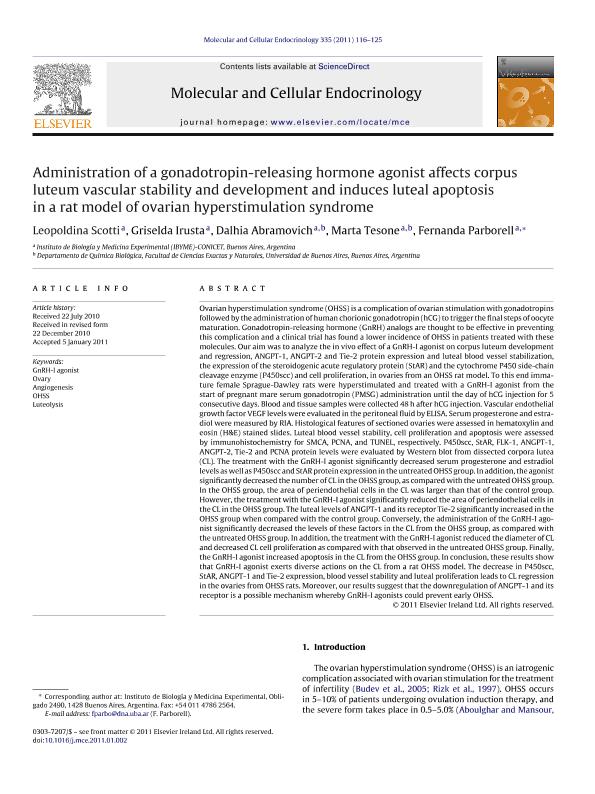Mostrar el registro sencillo del ítem
dc.contributor.author
Scotti, Leopoldina

dc.contributor.author
Irusta, Griselda

dc.contributor.author
Abramovich, Dalhia Nurit

dc.contributor.author
Tesone, Marta

dc.contributor.author
Parborell, Maria Fernanda Agustina

dc.date.available
2017-04-04T18:49:17Z
dc.date.issued
2011-03
dc.identifier.citation
Scotti, Leopoldina; Irusta, Griselda; Abramovich, Dalhia Nurit; Tesone, Marta; Parborell, Maria Fernanda Agustina; Administration of a gonadotropin-releasing hormone agonist affects corpus luteum vascular stability and development and induces luteal apoptosis in a rat model of ovarian hyperstimulation syndrome; Elsevier Ireland; Molecular And Cellular Endocrinology; 335; 2; 3-2011; 116-125
dc.identifier.issn
0303-7207
dc.identifier.uri
http://hdl.handle.net/11336/14776
dc.description.abstract
Ovarian hyperstimulation syndrome (OHSS) is a complication of ovarian stimulation with gonadotropins followed by the administration of human chorionic gonadotropin (hCG) to trigger the final steps of oocyte maturation. Gonadotropin-releasing hormone (GnRH) analogs are thought to be effective in preventing this complication and a clinical trial has found a lower incidence of OHSS in patients treated with these molecules. Our aim was to analyze the in vivo effect of a GnRH-I agonist on corpus luteum development and regression, ANGPT-1, ANGPT-2 and Tie-2 protein expression and luteal blood vessel stabilization, the expression of the steroidogenic acute regulatory protein (StAR) and the cytochrome P450 side-chain cleavage enzyme (P450scc) and cell proliferation, in ovaries from an OHSS rat model. To this end immature female Sprague-Dawley rats were hyperstimulated and treated with a GnRH-I agonist from the start of pregnant mare serum gonadotropin (PMSG) administration until the day of hCG injection for 5 consecutive days. Blood and tissue samples were collected 48h after hCG injection. Vascular endothelial growth factor VEGF levels were evaluated in the peritoneal fluid by ELISA. Serum progesterone and estradiol were measured by RIA. Histological features of sectioned ovaries were assessed in hematoxylin and eosin (H&E) stained slides. Luteal blood vessel stability, cell proliferation and apoptosis were assessed by immunohistochemistry for SMCA, PCNA, and TUNEL, respectively. P450scc, StAR, FLK-1, ANGPT-1, ANGPT-2, Tie-2 and PCNA protein levels were evaluated by Western blot from dissected corpora lutea (CL). The treatment with the GnRH-I agonist significantly decreased serum progesterone and estradiol levels as well as P450scc and StAR protein expression in the untreated OHSS group. In addition, the agonist significantly decreased the number of CL in the OHSS group, as compared with the untreated OHSS group. In the OHSS group, the area of periendothelial cells in the CL was larger than that of the control group. However, the treatment with the GnRH-I agonist significantly reduced the area of periendothelial cells in the CL in the OHSS group. The luteal levels of ANGPT-1 and its receptor Tie-2 significantly increased in the OHSS group when compared with the control group. Conversely, the administration of the GnRH-I agonist significantly decreased the levels of these factors in the CL from the OHSS group, as compared with the untreated OHSS group. In addition, the treatment with the GnRH-I agonist reduced the diameter of CL and decreased CL cell proliferation as compared with that observed in the untreated OHSS group. Finally, the GnRH-I agonist increased apoptosis in the CL from the OHSS group. In conclusion, these results show that GnRH-I agonist exerts diverse actions on the CL from a rat OHSS model. The decrease in P450scc, StAR, ANGPT-1 and Tie-2 expression, blood vessel stability and luteal proliferation leads to CL regression in the ovaries from OHSS rats. Moreover, our results suggest that the downregulation of ANGPT-1 and its receptor is a possible mechanism whereby GnRH-I agonists could prevent early OHSS.
dc.format
application/pdf
dc.language.iso
eng
dc.publisher
Elsevier Ireland

dc.rights
info:eu-repo/semantics/openAccess
dc.rights.uri
https://creativecommons.org/licenses/by-nc-nd/2.5/ar/
dc.subject
Ovary
dc.subject
Angiogenesis
dc.subject
Vegf
dc.subject
Ovarian Hyperstimulation Syndrome
dc.subject.classification
Biología Reproductiva

dc.subject.classification
Ciencias Biológicas

dc.subject.classification
CIENCIAS NATURALES Y EXACTAS

dc.subject.classification
Obstetricia y Ginecología

dc.subject.classification
Medicina Clínica

dc.subject.classification
CIENCIAS MÉDICAS Y DE LA SALUD

dc.title
Administration of a gonadotropin-releasing hormone agonist affects corpus luteum vascular stability and development and induces luteal apoptosis in a rat model of ovarian hyperstimulation syndrome
dc.type
info:eu-repo/semantics/article
dc.type
info:ar-repo/semantics/artículo
dc.type
info:eu-repo/semantics/publishedVersion
dc.date.updated
2017-03-08T15:18:05Z
dc.identifier.eissn
1872-8057
dc.journal.volume
335
dc.journal.number
2
dc.journal.pagination
116-125
dc.journal.pais
Irlanda

dc.description.fil
Fil: Scotti, Leopoldina. Consejo Nacional de Investigaciones Científicas y Técnicas. Instituto de Biología y Medicina Experimental (i); Argentina
dc.description.fil
Fil: Irusta, Griselda. Consejo Nacional de Investigaciones Científicas y Técnicas. Instituto de Biología y Medicina Experimental (i); Argentina; Argentina
dc.description.fil
Fil: Abramovich, Dalhia Nurit. Consejo Nacional de Investigaciones Científicas y Técnicas. Instituto de Biología y Medicina Experimental (i); Argentina. Universidad de Buenos Aires. Facultad de Ciencias Exactas y Naturales. Departamento de Química Biológica; Argentina
dc.description.fil
Fil: Tesone, Marta. Consejo Nacional de Investigaciones Científicas y Técnicas. Instituto de Biología y Medicina Experimental (i); Argentina. Universidad de Buenos Aires. Facultad de Ciencias Exactas y Naturales. Departamento de Química Biológica; Argentina
dc.description.fil
Fil: Parborell, Maria Fernanda Agustina. Consejo Nacional de Investigaciones Científicas y Técnicas. Instituto de Biología y Medicina Experimental (i); Argentina
dc.journal.title
Molecular And Cellular Endocrinology

dc.relation.alternativeid
info:eu-repo/semantics/altIdentifier/url/http://www.sciencedirect.com/science/article/pii/S0303720711000220
dc.relation.alternativeid
info:eu-repo/semantics/altIdentifier/doi/http://dx.doi.org/10.1016/j.mce.2011.01.002
Archivos asociados
